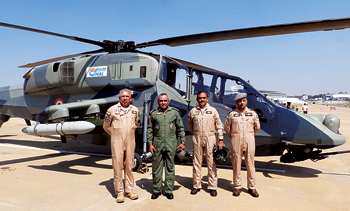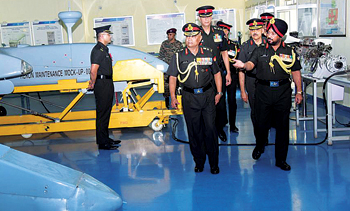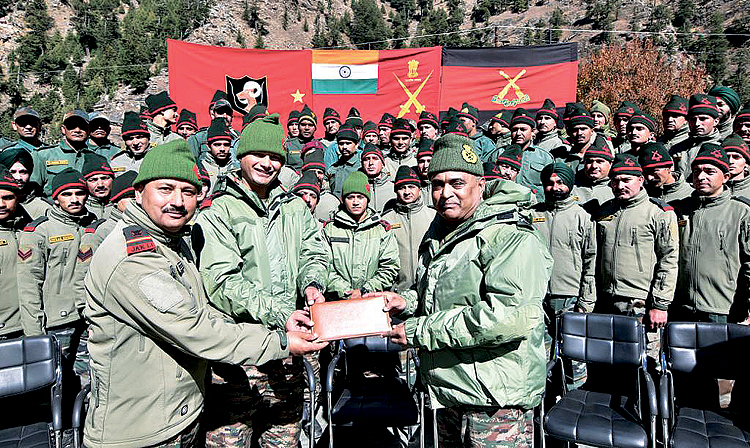INDIAN ARMED FORCES CHIEFS ON OUR RELENTLESS AND FOCUSED PUBLISHING EFFORTS

The insightful articles, inspiring narrations and analytical perspectives presented by the Editorial Team, establish an alluring connect with the reader. My compliments and best wishes to SP Guide Publications.

"Over the past 60 years, the growth of SP Guide Publications has mirrored the rising stature of Indian Navy. Its well-researched and informative magazines on Defence and Aerospace sector have served to shape an educated opinion of our military personnel, policy makers and the public alike. I wish SP's Publication team continued success, fair winds and following seas in all future endeavour!"

Since, its inception in 1964, SP Guide Publications has consistently demonstrated commitment to high-quality journalism in the aerospace and defence sectors, earning a well-deserved reputation as Asia's largest media house in this domain. I wish SP Guide Publications continued success in its pursuit of excellence.
- MoD initiates comprehensive review of Defence Acquisition Procedure 2020, pushes for defence reforms
- G7: The Swansong
- Kalinga Connect: South Asia to Polynesia
- Must Credit DRDO for Operation Sindoor, now what is next for defence R&D?
- The layered Air Defence systems that worked superbly, the key element of Operation Sindoor
- Operation Sindoor | Day 2 DGMOs Briefing
- Operation Sindoor: Resolute yet Restrained
Striking the Right Balance
In an interview with Jayant Baranwal, Editor-in-Chief, SP’s Land Forces, Chief of the Army Staff General Manoj Pande charts the ongoing evolution of Indian Army with a balanced approach that combines platform-centric capabilities with technology-centric enhancements

SP’s Land Forces (SP’s): Under the process of ‘Modernisation & Technology Infusion’, is Indian Army transitioning from Platform centric to technology centric force?
Chief of the Army Staff (COAS): Indian Army has embarked on several initiatives towards ‘Modernisation & Technology Infusion’. Major efforts are being made towards Upgrades, New Acquisitions & infusion of Niche technology. Our approach in this endeavour, firmly stands on the edifice of Atmanirbharta. The right balance between ‘Conventional’ and ‘New’ capabilities is being ensured in all the initiatives.
We have adopted a balanced approach that combines platform-centric capabilities with technology centric enhancements. While traditional platforms like tanks, guns, missile systems remain crucial for deterrence and defence, integrating technology-centric capabilities can enhance effectiveness and provide a competitive edge in the evolving threat landscape.
Indian Army has been actively working to adopt niche and advanced technologies to enhance operational capabilities and modernise the forces. Adoption of niche technology is part of our broader effort to transform the Indian Army into a more agile, technologically advanced, and selfreliant force. We have co-opted Academia, Startups, MSMEs, R&D organisations in addition to the defence industry in accelerating technology development and absorption which has manifested in significant advances in the fields of Al, Quantum, Unmanned System, Robotics to name a few.
We are investing heavily in technologies, especially in areas like Al, cyber warfare and space assets. Simultaneously, our rapid modernisation has a significant focus on domains like FRCVs, Missile Systems, Aviation assets, Precision munitions etc.
SP’s: How is Indian Army enhancing counter drone capability for protection of vital assets from hybrid threat during peacetime?
COAS: Indian army has identified the threat from drones or Unmanned Aerial Systems (UAS) and a credible response capability is being built through synergised efforts of Indian industry, DRDO and in-house Indian army initiatives. A number of systems have been contracted to counter the threat from drones or RPA. Some of the systems have already been operationalised.
Guidelines for countering drones, or RPA threat have been promulgated. India Army has also identified vital military installations meriting protection from UAS. We have also undertaken several training activities at the ground level so that hostile drones can be detected, identified and neutralised well before they can achieve their intended objectives. In coordination with the Ministry of Civil Aviation, vital military installations and facilities have been declared as no-fly zones on the Digisky portal with adequate buffers around them, preventing any commercial or civil drones from flying in the restricted areas.
“We draw lessons from ongoing conflicts, emphasising the continued relevance of hard power. Self-reliance is a major lesson, and as we infuse technology, issues of operational philosophy, tactics, and force restructuring are being addressed.”
Study of ongoing conflicts has also provided us inputs towards drone and counter-drone application and this is also being factored in our procurement as well as employment parameters.
SP’s: Indian Army had prepared a Compendium of Problem Statements to make defence industry understand the requirements of the Indian Army. How is the progress made so far?
COAS: Compendium of Problem Definitions Statements (CPDS) 2023 consists of 110 Problem Definition Statements. It defines emerging requirements of the Indian Army that require technology-based solutions from the defence manufacturing and R&D ecosystem in 20 Niche Technology domains. This compendium was released by the Defence Minister on February 15, 2023.
The CPDS 2023 received an overwhelming response from the environment and as on date 462 Project Proposals have been received from the Industry and the Academia, to include 257 from Industry, and 205 from the Academia.
These proposals have been examined with the assistance of Subject Matter Experts from Department of Science and Technology to select the best possible technical solution.
As a result, 22 Projects have already been initiated through various available routes of R&D/D&D ie. IDEX, TDF, ATB and MAKE. Eight solutions are under No Cost No Commitment demonstration and the development route of the balance is going to be finalised shortly.
Apart from reinforcing our operational capabilities, these projects will play a significant role in propelling the indigenous R&D and production ecosystem on a higher growth trajectory.
SP’s: Logistics and maintenance expenses of a large standing Army is always debated. How is Indian Army leveraging the development of civil infrastructure and efficient management techniques in this field?
COAS: Recent conflicts have brought to fore the importance of maintaining a self-reliant, lean and efficient armed force. Advancements in all sectors being made by the nation provide us greater access to services and commodities even in the far-flung regions and therefore the age-old concept of Armed Forces being completely self-contained and the requirement of inherently developing all capabilities, in today’s scenario becomes both unviable & uneconomical. It is therefore imperative that efforts towards logistic sustenance of forces be optimised by suitably exploiting civil military fusion. Our efforts in designing the logistic set up today are aimed at achieving this.


Indian Army has suitably interfaced with PM Gati Shakti to take into consideration our requirements & optimally utilise the civil infrastructure thus enhancing the overall logistic capability.
We have made changes in our policies to tap into civil infrastructure for transportation of vehicles having wide usage in the country. Policy changes have also been made to exploit the maintenance & repair facilities available in the civil, especially by the static units.
Joint Logistic Nodes have been established to deliver shared logistics commodities and services to the units and personnel of all three services at common military stations. This has enhanced the logistic functions and helped in understanding each other’s procedures & processes.
We have taken numerous outsourcing initiatives intending to enhance efficiency in logistics. Presently, approximately 1,200 projects for 1,228 crore are under progress. This is also helping us to realign the combatant manpower to core tasks while outsourcing non-core tasks.
Logistic entities like 3rd line MT Battalions and Pioneer Companies are being considered for conversion to Territorial Army units/subunits thus retaining the operational capabilities while accruing savings.
In addition, a comprehensive exercise to streamline inventory management by reducing the dead inventory and capitalising on availability of items ex-trade on Government-e-Market (GeM) is being undertaken to reduce the centralisation of procurement and provisioning.
SP’s: In light of Russia-Ukraine and Israel-Hamas conflicts, changing geopolitical situations and emerging technologies, is the Indian Army considering revising its warfighting doctrines while modernising its military hardware?
COAS: Doctrinal precepts are dynamic and evolve with the changing character of war, technological development and threat paradigm. We are certainly monitoring the events unfolding in the Russia-Ukraine, as well as Hamas-Israel conflict, as it will churn out important Geopolitical, technological, economic and military lessons. Not only India, but all countries of the world would be analysing these.
The continued relevance of hard power as the ultimate instrument to preserve national interests, when red lines are breached, and all other instruments of the state appear ineffective, has been adequately reinforced.

Land has yet again featured as the decisive domain of warfare. It is clear that conventional wars are still a reality and India must remain adequately prepared.
Capability development for a full spectrum of conflict must remain an ongoing endeavour. Self-reliance or Atmanirbharta is a major lesson that we have drawn from the conflict. We cannot let our national security be dependent upon global disruptions. Hence, the approach towards self-reliance is an extremely pragmatic and relevant one.
“Integrating technology-centric capabilities enhances effectiveness and provides a competitive edge in the evolving threat landscape.”
Indian Army is closely following the ongoing conflicts, undertaking various studies to derive lessons on relevant aspects and these are being assimilated into our training. These include aspects related to the tactics and technology being employed, leadership qualities on display, the effect of morale on fighting and force structuring and combined operations.
Concomitant to these developments and the infusion of technology into our warfighting systems, issues of operational philosophy, concepts of employment, tactics and commensurate force restructuring, are being addressed.
SP’s: How do you intend to push the pace to achieve better jointness and tri-service integration?
COAS: Tri-Services integration offers significant opportunities, and we are making substantial strides in fostering cross-linkages to pool our capacities and capabilities. Indian Army is committed to advancing jointness and integration initiatives. We fully support the progress made so far and recognise the importance of consolidating the capabilities of three Services. Ongoing efforts have resulted in a deeper understanding of each other’s strengths and areas for further focus.
Theaterisation is one of the many jointness and integration initiatives that have gained momentum. Its primary objective is to enhance interoperability, synergistic operational planning and execution, reduce asymmetry through combined effects, optimise efforts, and exercise financial prudence.
The establishment of an Integrated Capability Development System (ICADS) has been realised. This will not only result in more cost-effective outcomes but will also ensure the commonality of equipment and increase interoperability. Furthermore, three Joint Logistics Nodes are fully operational, with plans for four more locations to be merged. Five Joint Training Institutions have been established to align our institutional training capacities for maintaining technical competencies. Throughout these changes, we strive to absorb and preserve best practices without compromising their efficacy.
While we prioritise significant projects, we equally value the cumulative impact of smaller initiatives. Among the ongoing endeavours are Cross Postings, Joint Exercises, Common Operational & Intelligence Picture, Common Service Alertness Levels, Joint Doctrine Development, Common Confidential Reports for Majors General and above, Common Aviation Safety Standards, Common Aviation Basing and Engineering Support, establishment of the Defence Communication Network under HQ IDS, Joint Procurement and Joint Repair & Maintenance. For us, jointness and integration is an inescapable ‘way of life’ and we are well on our way to accomplish it.
Concomitantly, we are reaching out and synergising with other Government agencies and departments towards augmenting our collective metric as instruments of the nation’s Comprehensive National Power. These inter alia include various Ministries of Government of India, State Governments, other uniformed services, etc.





